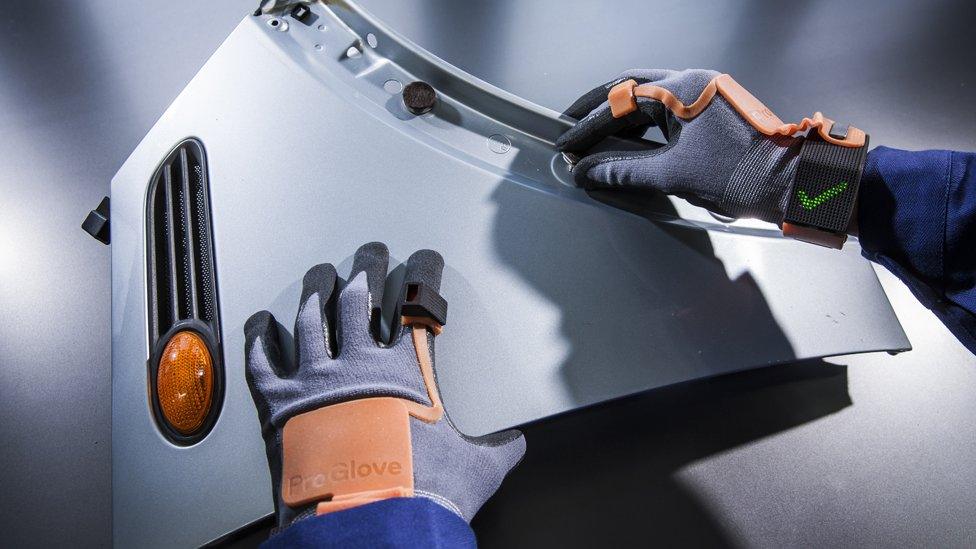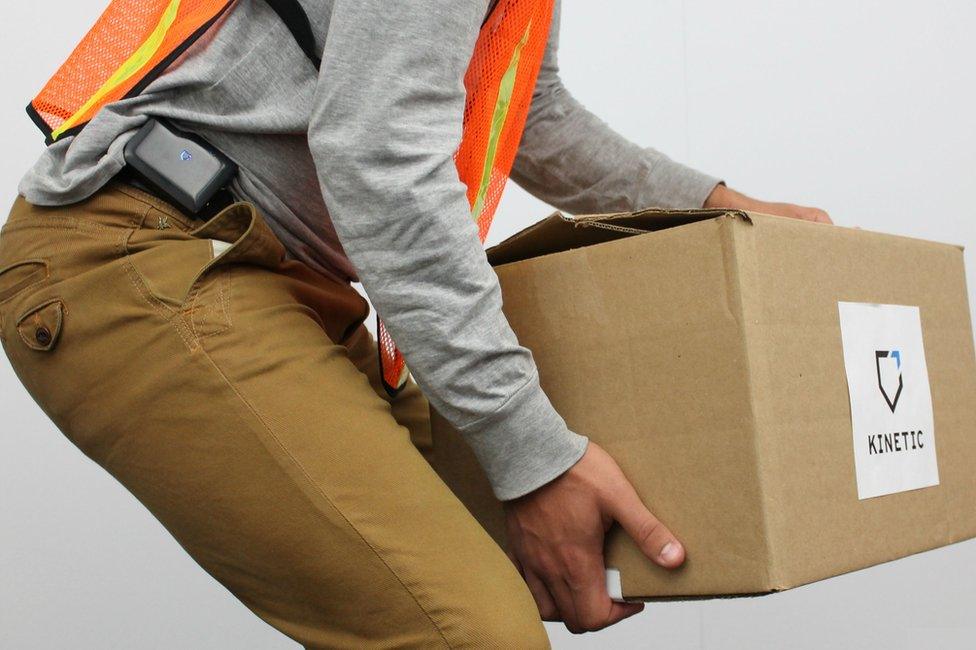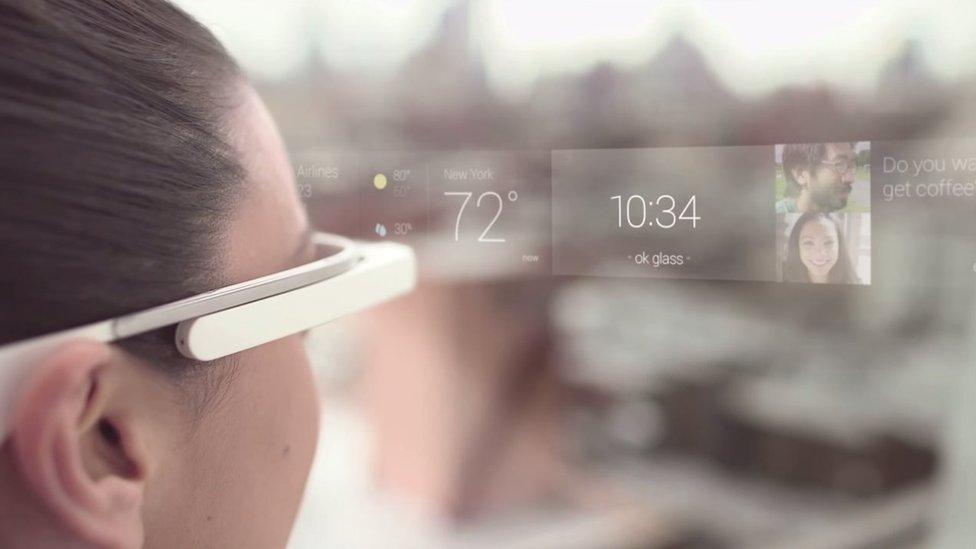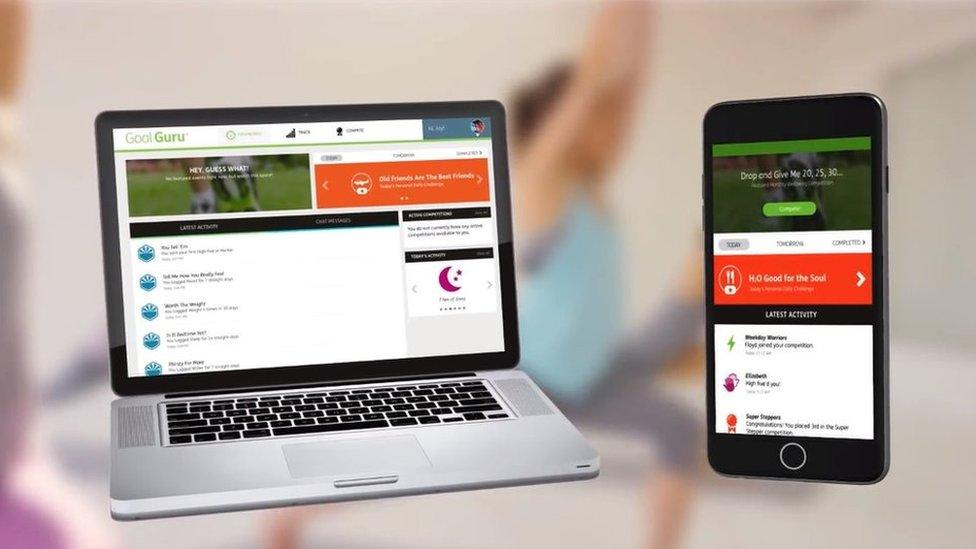What one piece of tech would transform your working life?
- Published

The smart glove can scan bar codes quickly and leaves hands free to hold other objects
What one piece of technology would most improve your working life?
Chances are it wouldn't be a glove. But car workers in Germany are now using smart gloves that not only save time but prevent accidents as well.
It is an example of how tech-enhanced humans are fighting back against the seemingly unstoppable rise of the robots.
At BMW's spare parts plant in Dingolfing, for example, which employs around 17,500 people, hand-held barcode readers have been replaced by gloves that scan objects when you put your thumb and forefinger together. The data is sent wirelessly to a central computer.
The hi-tech gloves allow workers to keep hold of items with both hands while scanning more quickly. While this may only save a few seconds each time, BMW reckons it adds up to 4,000 work minutes, or 66 hours, a day.

The gloves can also tell workers if they're using the right components
Formally launched in November, ProGlove's "plug and play" Mark glove is fitted with an integrated scanner and battery with enough charge to last an eight-hour shift. It costs €1,300 (£1,095; 1,350).
Other companies using the glove include rival car makers Audi and Skoda, and precision engineering firm Festo.
"The access point is connected to a company's existing system via USB or a normal serial connector, meaning the glove can be deployed with no integration expense," says ProGlove chief executive Thomas Kirchner.
Giving business a lift
In the US, sick leave costs employers $226bn (£182bn) a year, while in the UK over the last 12 months firms lost more than £4bn on leave related to minor ailments.
Lifting-related injuries alone cost US businesses more than $70bn last year. After flu, back pain is the main cause of absenteeism.
New York-based tech company Kinetic is trying to address this issue with a belt-mounted device that senses workers' posture when lifting and gives them feedback when the position could be improved - by bending the knees more, for example.

Kinetic's smart belt tells you if your posture is bad when lifting objects
Managers can see all the collected data on a dedicated web page, helping them to spot areas for improvement. The Kinetic system also gives advice on how workplaces could be redesigned to reduce potentially dangerous practices.
The system has recently been piloted at Crane Worldwide Logistics' distribution facility in Texas, where it helped reduce the number of potentially damaging lifts performed by workers each day by 84%, the company says.
Heads-up
Such wearables are helping humans give robots a run for their money.
For example, aircraft manufacturer Boeing has been piloting a version of Google Glass, the search giant's augmented reality eyewear, to help technicians wire up its planes.
These highly complex webs of wires - known as harnesses - have to be connected up according to a road map that technicians refer to on a laptop or tablet.
But now they can read the instructions on the head-mounted display, thanks to a specially developed app called APX Skylight, leaving their hands free to carry on snipping the wires to length and connecting them up.

Google Glass received a lukewarm reception from consumers, but businesses are more enthusiastic
Boeing says the pilot saw assembly times reduced by 25%, and crucially, the number of errors fell, too.
And in the mining industry - one of the most dangerous in the world - technology is helping to keep miners safe and improve production.
For example, Canadian company Maestro Mine Ventilation has developed an award-winning digital gas sensor that is more accurate than traditional sensors.
By constantly monitoring the quality of the air, the build-up of dangerous gases can be spotted earlier and fresh air pumped to those areas. This can also save on electricity as the fans can be operated only when needed rather than all the time.
Wellbeing
It's not just physical injury that can lead to absenteeism - stress and illness are prime culprits in the workplace.
IT giant Oracle claims its absenteeism costs have plunged by $1m as a result of wellbeing interventions such as stress workshops.
US health insurer Humana believes its Goal Guru health and wellbeing app can increase productivity by improving employees' overall fitness.
The "digital coach" app gathers data from multiple fitness trackers and mobile health apps and sets challenges that staff can take part in individually or collectively - from push-ups to mountain treks.
Competition between teams - and even heckling - is actively encouraged.

Humana's Goal Guru app aims to make workers feel better emotionally and physically
"Goal Guru is not just about the number of steps you have done or what you have eaten," vice president of wellness Kristine Mullen tells the BBC.
"It includes tasks designed to reduce financial stress and improve emotional wellbeing as well as physical condition, all while creating a spirit of competition and fun within the employee community."
The app, which is currently only available to US companies but should soon be worldwide, costs from $1 to $1.50 per employee per month for a business with 100 employees, she says.
"Our research indicates that employers are now happy to spend twice as much as that because they understand the effect a cohesive employee community has on their bottom line," Ms Mullen says.
So whether it's smart gloves, clever belts or motivational software, technology is helping to make us healthier and more productive at work.
And with robots stalking our jobs, that's probably just as well.

Follow Technology of Business editor Matthew Wall on Twitter, external and Facebook, external